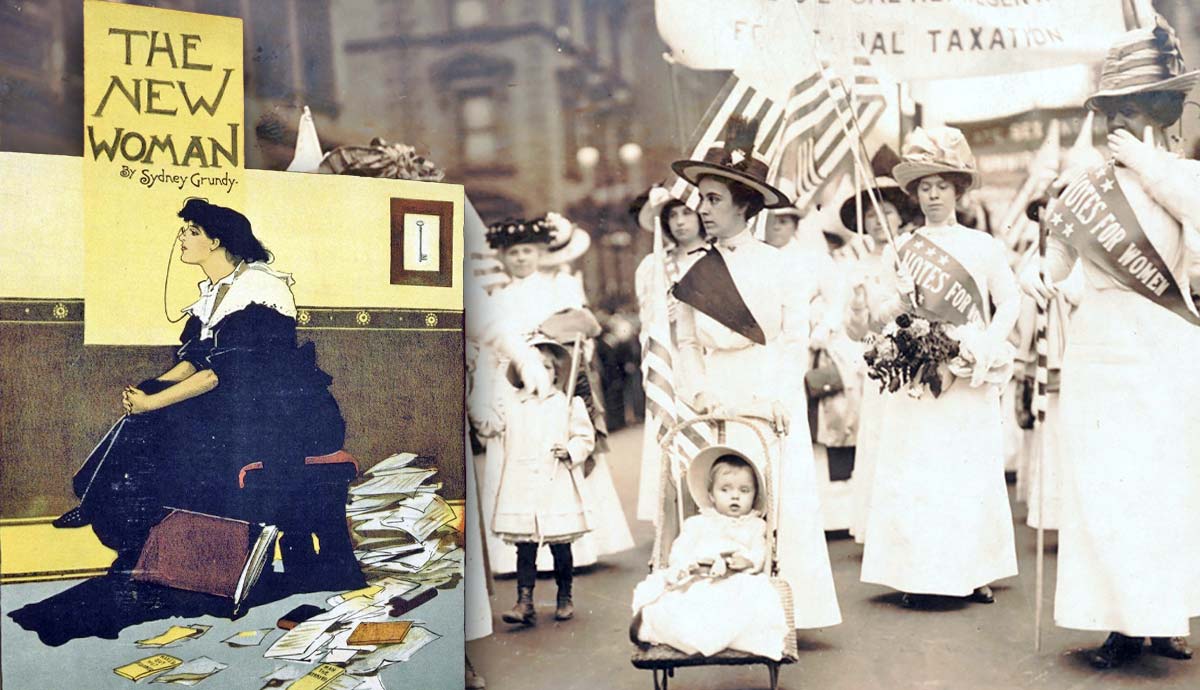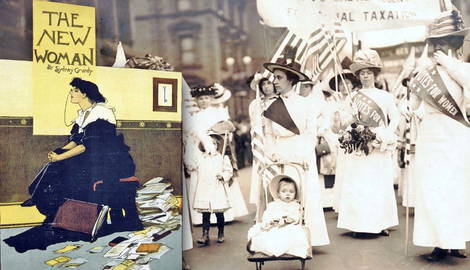
Reinventing womanhood, the New Woman championed ideals of freedom and individualism and began to gain momentum in various societies in the early 20th century. A force to reckon with, she took the form of the Flapper in America, the Modeng xiaojie in China, and the Neue frau in Germany. Let’s explore the multi-faceted lives of the New Woman and how they paved the way for the larger feminist movement that was taking shape at the time.
Before the New Woman: Femininity in Victorian Times

Before the New Woman was born, a woman’s place in 19th-century Britain was largely confined to the home. She subscribed to the ideals of family, respectability, and motherhood, modeled after the example set by Queen Victoria. Hailed as the mother of the nation, Queen Victoria epitomized putting the family and the home before any feminist agenda. Her marriage to Prince Albert was characterized by marital bliss and familial harmony, reminding millions that the domestic space was sacred and more important than anything else. As such the Victorian era became synonymous with domesticity, a potent force that influenced the larger Western society. Nonetheless, not everyone resonated with the idea of staying home and maintaining the façade of a happy wife subservient to her husband.
The Angel in the House vs. the Fallen Woman

Victorian ideals of morality and sexuality generally categorized women into two groups: the good-natured, moral Angel in the House, or the oversexed, promiscuous Fallen Woman of the streets. Historically, the idea of the Angel in the House was first used by English poet Coventry Patmore in 1854 to celebrate his wife’s perfection. Later, it was increasingly used to idealize the perfect, docile homemaker of the late 19th century.
The notion of being an Angel in the House confined a woman within the domestic sphere. She was expected to sacrifice her sense of self in favor of the family’s moral and physical well-being. The twinned forces of the cult of domesticity and separate spheres reduced womanhood to the dominating roles of a wife and a mother. Conversely, as an antithesis to the Angel in the House, the Fallen Woman referred to one who had tumbled down the abyss of immorality and decadence. This applied to a broad range of women, from the common sex workers to the high-class courtesans and royal mistresses.
New Woman, New Ideals

Despite the Victorian society’s dichotomized understanding of women, a new discourse soon surfaced in the late 19th century, The term New Woman, originally coined by English writer Sarah Grand in 1894, was used to describe women “who exercised control over their own lives be it personal, social, or economic.” Noteworthy is the broad use the term encompassed as times evolved.
In the 1890s, a New Woman demonstrated economic independence and held professional roles. In the early 20th century, the term referred to women representing radical change such as suffragists or reformers, athletes, scientists, and aviators. The Flappers during the 1920s gave the term a new definition as they pursued thrill, liberation, freedom, and independence in the spheres of morality and sexuality. Her counterparts in China and Germany—the Modeng xiaojie and the Neue frau, respectively—would also champion similar ideals.
The New Woman in Action

A typical New Woman of the time was an educated feminist. She believed in challenging and overcoming prevailing gender norms that had for too long favored men. Her independence and refusal to subscribe to male-centric beliefs thus empowered her to become a more active member of society. This was reflected in her dressing, physical activities, social behaviors, as well as her engagement with the world outside the domestic sphere. As more women received higher education in the late 19th century, they became more active in literature, theatre, and academia. In America, women’s colleges such as Bryn Mawr, Mount Holyoke, and Wellesley welcomed the New Woman.

In particular, cycling became a new form of expressing freedom and independence. In the 1890s, an unprecedented bicycle craze swept the American and European societies. Not only did the act of riding a bicycle allow a woman to venture into the streets, but it also gifted her with the freedom to explore modified outfits that accommodated cycling. The most famous of all was the Bloomer costume, which deviated from the cumbersome and constrictive corsets of the time. This costume featured full trousers that were gathered at the ankle and paired with a calf-length skirt, completed with a trendy jacket.
The New Woman and the Agitation for Rights

An important sphere of influence for the New Woman was the vocal movements agitating for rights in several aspects. Some women came together to achieve their common goal of suffrage while others fought for other causes such as free love and labour rights. Many of these movements decried the double standards of societal norms which had chained women to the domestic sphere. While the New Woman bravely fought for the causes she believed in, she was often portrayed as loud and unattractively dressed in the media. This was attributed to the prevailing worry of a social and cultural overhaul fronted by a generation of newly independent women. Conservatives feared that the New Woman movement might result in a reversal of gender roles, birthing a society where men became sidelined or worse—feminized.
The New Woman in America: Gibson Girl and Flapper

In the early 1900s, illustrator Charles Dana Gibson created what would become one of the earliest manifestations of a New Woman. Known as the Gibson Girl, she embodied the ideal look and style of American girls at the turn of the 20th century. With an S-curved torso, the Gibson Girl was characterized by her heavy bosoms and large hips.

She was known for her athletic and fashionable lifestyle and was among the privileged people who had access to higher education. Straddling the fine lines between being progressive and dabbling too much in politics, the Gibson Girl was also noteworthy for her reserved participation in the struggle for suffrage. The more volatile and liberal descendant of the Gibson Girl was the Flapper, who would take the world by storm during the Roaring Twenties two decades later. Emerging in the interwar years, these women chased a lifestyle characterized by smoking, alcohol, partying, and sexual freedom.

These women ditched traditionally desirable feminine qualities and were often chastised in the media for their boisterous personalities. Nonetheless, they left their imprint on popular culture with their revolutionary bobbed hairstyle, glamorous makeup, and memorable slang. As the 1920s gave way to the 1930s which were characterized by economic hardship and looming war, the Flapper and her merrymaking lifestyle soon became frowned upon and phased out.
The New Woman in China: Modeng xiaojie

At the turn of the 20th century, China was grappling with an ailing imperial dynasty, alongside widespread sociocultural upheavals. The prominent New Culture movement of the time advocated for a new China that was built on progressive, modern, and democratic ideals. It promoted the use of scientific methods to resolve social problems and pushed for the end of patriarchy in favor of women’s rights. It was in this climate of vast societal change that the Modeng xiaojie or Miss Modern was born. Instead of the traditional Chinese belief of women being good wives and wise mothers, these women sought economic independence, higher education, and equal rights.

As China’s answer to the New Woman, the Modeng xiaojie advocated choice in courtship and denounced the stifling Confucian marriage traditions. A consequential takeaway from the modern woman’s crusade for feminine autonomy was the belief in sexual liberty, a byproduct of promoting free love. A symbol of Western-styled modernity replicated on Asian faces, the Modeng xiaojie was also characterized by her permed hair, fashionable clothes, high heels, as well as powder, rouge, and lipstick. This was a far cry from conservative Chinese definitions of femininity that emphasized subtle and natural beauty. As the fashionable styles of the Modeng xiaojie gained prominence, beauty products of the time were marketed to appeal to this emerging group of consumers. The Modeng xiaojie and her avant-garde, westernized style would go on to define what was trendy during the Republican era until communism descended on China in 1949.
The New Woman in Germany: Neue frau

While her Chinese and American counterparts opted for more liberal clothing and embraced a new form of femininity, the German New Woman took it a step further. Known as the Neue frau, the German New Woman donned relaxed, masculine clothes, radically departing from the traditional idea of womanhood in Germany. During the Weimar era, political strife and rapid social change went hand-in-hand. While the government struggled to gain popular support and improve the ailing economy, the cultural spheres experienced an unprecedented flowering. Relaxed censorship contributed to a flourishing entertainment industry and bustling nightlife, functioning as fertile grounds for liberal expressions of sexuality and identity.

It was in this transformative era that the Neue frau thrived. She frequented nightclubs and cabarets, flaunting her most fashionable androgynous clothes and bobbed hairstyles. Captivating visuals of the Neue frau dominated shopping catalogs, street advertisements, and even the silver screen. She had both the independence and the purchasing power, often working white-collared jobs that could pay for the consumerist lifestyle many envied. Backlash towards the rising popularity of the Neue frau, however, existed as well. They faced criticism from the conservatives who blamed the Neue frau for a series of problems facing Germany. These ranged from falling birth rates and increasing divorce rates to the perceived decline in morality. After the Nazis came to power in 1933, the Neue frau virtually vanished as the state reinstated the traditional ideals of Kinder, Kuche, and Kirche (children, kitchen, church) for women.
While the Flapper, Modeng xiaojie, and the Neue frau eventually succumbed to economic forces as well as political changes in their respective countries, their legacy as the New Woman remained. For subsequent feminists, the New Woman’s courage to pursue an alternative lifestyle contrary to society’s heteronormative, child-centric norms became a beacon of inspiration. In more ways than one, the New Woman was ahead of her time, championing beliefs that prioritized her rights, well-being, and happiness. Today, the New Woman’s spirit of standing up for herself continues to inspire generations of women as they continue to fight for various issues—from demanding equal pay to calling out workplace harassment.










